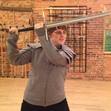Claire Ryan's Blog, page 13
January 9, 2015
Grimdarkness in Fantasy
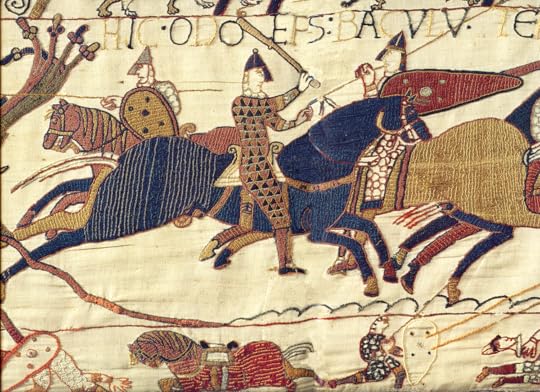
Or, as I like to call it, Game of Thrones syndrome!
I can’t really get into grimdark fantasy. Not to rag on George R.R. Martin, but a lot of it comes off as being, well, just there for shock value, and I can’t stomach the stuff. But my big issue is that there’s usually a lot of overtones of REALISM, with the implication being that this horrible world of horribleness was what the Dark Ages in Europe were really like, instead of the lighter, fluffier variety of regular fantasy.
This drives me insane, I tell you. I mean, I don’t even know how you can attach the word ‘realistic’ to a story that involves magic and dragons, for example. It does worry me as well that people will start thinking that the actual Dark Ages were really just like that, which is so far over the horizon of wrong it’s not even on the same map anymore.
So here’s the short version: the Dark Ages should be rightly called the Middle Ages, i.e. the time from around the decline of the Roman Empire and before the Renaissance. There was no abject tyranny going on – do you know how costly it is to have to oppress people all the time? The Christian Church evolved into the Roman Catholic version in the west, and the Orthodox in the east. Monasticism rose to prominence, and missionaries travelled around doing their thing.
Writing and art was created. The finest and most beautiful illuminated manuscripts were bound. The great fighting treatises, from which came the techniques I learn today, were written by the European swordmasters. The Islamic Golden Age took off in a big way, with discoveries and scholarship to put the west to shame.
The Black Death changed the face of Europe in a huge way, as did various wars and famine – but it wasn’t all death, all the time. People were not being killed all over the place. Women were not being raped to death all the time.
Did I mention that? Women were not being raped all the time. Raping a woman was a crime punishable by death in the Roman Empire, and that lasted well into the middle of the Middle Ages. Women controlled the household, from the lowest peasant up to the nobility. They held the power that linked families and communities together; they didn’t sit around passively and let everything be run by men, because – yet again – who’s got the time for that when you’ve got wars to fight and political alliances to make?
People were not constantly starving to death, for gods’ sake. Yes, lots of people died, but there were lots of people who survived, and do you really think their lives were nothing but doom and gloom? Do you really think their lives were awful 100% of the time, that all they did was suffer?
I don’t believe it for a second. Even in the middle of the Great Famine in Ireland, for example, there was still light and laughter and hope. There always is. I think what really annoys me about grimdark fantasy is that it seems to want to reflect only the worst of humanity and call that reality, when reality actually sits somewhere in between that and fluffy bunny lollipops.
All I know is I honestly can’t write it.
Related Posts:
The Swordplay of Lord of the Rings
The post Grimdarkness in Fantasy appeared first on Raynfall.
January 8, 2015
An Author’s Life, or Why I will Never Do a Kickstarter

So… let’s talk about the business of writing.
It’s definitely a business, unless you’re writing and posting your stuff for free online. (Or just using it as parrot cage lining.) Being a professional writer is a tough gig. It’s hard to convince readers that your work is worth a couple of bucks, but we have to eat somehow. Writing isn’t powered by moon dust and unicorn farts.
So you’ll excuse me if I find it profoundly offensive that anyone thinks that a professional writer should work for free.
An author put up a Kickstarter for the sequel to one of her novels, asking for a meagre $10,000 to cover production and living expenses, and the Internet collectively lost its shit that this author had the unmitigated gall to ask for money to live on.
And there was whining, and crying, and the usual assholery (that is totally a word) tossing shit on this author because she ‘didn’t phrase it right’ or because she was asking for too much or because she is totally privileged and how dare she ask for money or offer people blog content or – just read the link above, good grief.
I have no patience for this crap.
They then dumped more shit on this author for stopping the Kickstarter and shutting down her social media accounts, as if she was just meant to take all this shit without becoming profoundly affected by it. Apparently there were aerial photos of her home – her home – emailed to her. Because she put up a Kickstarter and asked for money to write a book I DON’T EVEN KNOW, SERIOUSLY.
Chuck Wendig has about all I’d like to say on the matter outside of a string of swearwords, but I will add this much:
You do not have the right to criticize how much money people ask for, or what they use that money for, on a site where some idiot convinced the Internet to give him $55,000 to make potato salad. Who other people give their money to is none of your damn business unless it’s an actual scam, and the very second you engage in harassment because you’re outraged by someone asking for money to do a thing you find ridiculous, you have officially lost your moral high ground and you need to Stop.
I mean – aerial photos?! If anyone tried that on me, I’d sharpen my longsword and make it very, very clear that anyone who threatens me or mine had better be ready to face me in single combat!
I don’t work for free and I’ll be damned if I have to justify that to anyone. My heart goes out to this poor author. No one deserves this just for wanting to devote all their time to writing a book for their fans.
Related Posts:
So You Just Want to Write
Why You Should Be a Writer
“Writing is the closest thing we have to telepathy…”
Piracy is Not the Bogeyman
An Update to the LendInk Author List
The post An Author’s Life, or Why I will Never Do a Kickstarter appeared first on Raynfall.
January 7, 2015
On plate armour, movement, and fighting with longswords
More required watching for the interested: how knights moved in plate armour, and some examples of combat.
This is fascinating to me because, as you can see, a hard strike from a longsword will not even dent plate armour! This is why half-swording was invented. Fantasy authors take note!
Related Posts:
Syrio Forel vs. The Lannister Guards
Interested in swords and bows?
Drizzt Do’Urden and the Infamous Parry
The Problem With Lightsabers
The Best Movie Swordfights – The Princess Bride
The post On plate armour, movement, and fighting with longswords appeared first on Raynfall.
January 6, 2015
Interested in swords and bows?
So I follow some very smart people on Youtube, and one of them is Matt from Schola Gladiatoria in the UK. Following on from something I touched on in the post about Drizzt, here’s a video about stereotypes on the use of swords and bows in media.
He makes some great points about the notion that using a sword equals strength, and using a bow equals dexterity. Every fantasy author should watch this!
Related Posts:
On plate armour, movement, and fighting with longswords
Drizzt Do’Urden and the Infamous Parry
The Problem With Lightsabers
Syrio Forel vs. The Lannister Guards
The Best Movie Swordfights – The Princess Bride
The post Interested in swords and bows? appeared first on Raynfall.
Drizzt Do’Urden and the Infamous Parry
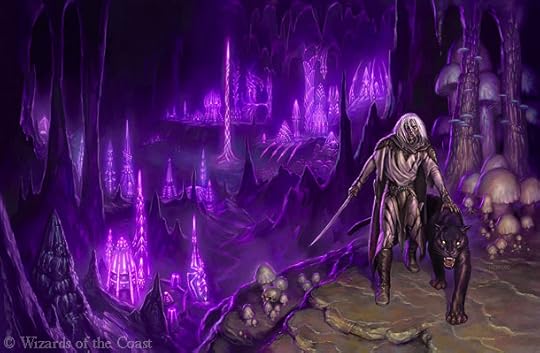
Let’s take a break from movies, and delve into books for a second.
This comes up every once in a while in the salle, among people who know Dungeons & Dragons (hi Matheus!): the double cross down parry, and the counter executed by Drizzt Do’Urden. This is of some interest to me because I do some training with a case or pair of rapiers, though I use smallswords because it’s hella tough on the arms. Dual weapon fighting is very interesting! Here’s what I’ve said before about it, while I was on Tsu.co and musing about random stuff:
“Historically, dual-wielding swords just didn’t happen, especially in war. But one-on-one techniques did and do exist, especially in eastern martial arts. What you notice about these techniques is that they use one long/one short, or two short swords or knives.
Why is that? Well, I think it’s because two longer weapons are easier to tangle up, especially against an opponent who knows their stuff. It’s also harder to learn how to use a pair of weapons – splitting your mental focus and reaction time at high speed is a level of multi-tasking that a lot of people just can’t do, regardless of what you see in the movies.
The eastern techniques seem to focus on extending their unarmed techniques using weapons. What I’ve noticed in the western weapon-only styles (that I’m familiar with, anyway) is that they focus on doing different simultaneous actions with two different weapons – the rapier and main gauche or dagger, for example – or the same actions, with the same weapons, but in sequence.
I experimented with this, and here’s what I think is going on here: dual-wielding a pair of matching swords might give you some real benefit IF you could learn how to parry with one and attack with the other, but at the same time and with whichever sword gives you the best advantage. So attack with the left while parrying with the right, or attack with the right while parrying with the left. This would give you a major boost over someone fighting with a single sword of the same style because you have more options, and you’re not limited to parrying THEN attacking.
However – learning how to do this consistently and at the same level of skill as what you have with a single sword is like trying to tapdance on the moon, because you’re hitting the limits of human brain multi-tasking. And after all that, it’s still not any better than using a sword and shield, and you’re less well defended because you can’t pull one side of your body back to protect it – gotta keep that second sword in range!
So, in conclusion – the classic dual-wielding we see in movies and books is historically rare because it’s ludicrously difficult to train, takes too much effort to actually do in real combat, and doesn’t give you any benefit vs. an offensive + defensive combo. I know some really top notch swordfighters do it very well, but I think they’re the exception that proves the rule. You can teach anyone to use a rapier, but only a few can learn how to use two.”
The Double Cross Down Parry
So – Drizzt is known very well for being an excellent dual-wield swordsman, and this parry comes up in the book Homeland by R.A. Salvatore. The sequence, if I understand it correctly, is that an attacker thrusts at a defender with both weapons, and the defender crosses their swords in front of them in a shortened V or X shape, catches both blades, and drives the points down before backing off. Drizzt’s counter to this, as the conventional wisdom was that there was no attack possible from the parry, was to execute the parry and then kick over his swords into the face of the attacker.
I read Homeland and thought it was quite good, but Salvatore spent far too long geeking out over the sword stuff. And, like many things in books, this particular maneuver will get you killed, because it breaks some very basic rules of defense in swordplay.
Crossing the line
This is one of the first things we learn. You must cross the center line to drive your opponent’s sword to the left or right, not up or down. This is a simple spatial alignment – the shortest distance from your body (a target) to not-your-body is almost always in the horizontal plane, so parrying left and right is the fastest and most effective way to protect yourself when attacking or defending. We can drive the sword down to get leverage, but you cannot ever forget the crossing or you’re going to get stabbed.
So the double cross down parry fails on its face, solely because it doesn’t respect the crossing. It’s a longer, more risky action to drive a pair of incoming swords down, and possibly into your legs, than to drive them to either side.
Versatility
This is my other beef with the parry itself – if you screw it up, you’re basically in deep, deep trouble. Crossing your swords in front of you is a hilariously bad idea because, like I said above, it’s much easier to tangle up your weapons. It also only takes a second for the opponent to step back, disengage over the cross, and thrust through your now-exposed chest with the sword of their choice, and there just isn’t any good response to that from a cross in front. So the parry also assumes that the opponent is completely stymied by it, which really isn’t the case.
Two swords vs. two swords
Something I’ve noticed, over and over again, is that storytellers seem to think that a pair of swords must be (a) better than a single sword in all instances, and (b) if both fighters have a pair, that two swords must defend against two swords. What I mean by that is that if one attacks with both weapons, the other must defend with both weapons to survive. And… no. Neither is true, sorry.
I think I’ve explained the first well enough above. The second can be seen in this parry specifically – one attacks with two identical actions, and the other responds with both swords to defend. But this just isn’t necessary! A double-thrust is still defeated by a parry to either side with one weapon, because the same attack in the same line with two weapons behaves exactly like an attack in that line with one. The strength of dual-wielding, if one exists, is when a fighter can perform two different simultaneous actions with the weapons – in this case, two different attacks of which the other fighter can only defend against one. And this isn’t to mention the fact that a fighter who thrusts with both swords at the same time is pretty much asking to get stabbed, seeing as they’ve left themselves with no defense at all if they’re parried.
The physics of swords – which are basically levers, when you think about it – favours whoever can win the crossing and get leverage over their opponent’s weapon, no matter how many weapons that opponent is attacking with.
The kick
Okay, leave the parry to one side for a moment. The kick over the top of your crossed swords, people. Assuming you actually perform this parry and pull it off without getting stabbed in the crotch or legs, why, WHY would you kick someone in the face? You have two swords here, both of which are sharper and better at doing lethal damage than your foot. They also come with the added bonus of not being your fleshy foot which you need in order to move around, and so they can take a hit from another sword without disabling you. Now consider that, if both swords are crossed in front of you, and assuming that your opponent hasn’t laughed at this point and stabbed you in your unprotected chest, you can raise whichever sword is on top and counterattack immediately. No need to unbalance yourself or put your fleshy body parts out where they can be chopped off.
See what I mean? This is not good swordplay. It’s a wonder that Drizzt survived to make it out of the Underdark.
This isn’t to say that the book is bad – again, I liked it a lot. But this is the fantasy equivalent of Tom Clancy’s obsession with boring military details; if you’re going to totally geek out over swordplay, you need to get the details right, and that largely means getting the physics and biomechanics right. Salvatore can write so well, and I enjoy his battles, but… damn, man. He’s said that he got the ideas for Drizzt’s style from hockey and acrobatics, of all things. This irks me just a bit – it gives the impression that he thinks of swordplay as being a strength game, where knights bashing each other with big, heavy swords is the norm. We already know from historical records, and from the massive HEMA community, that a merely strong swordfighter will lose every single time to a skilled one.
Get a big enough lever and you can move the world. Physics matters a lot more than you’d think, when you’re fighting with what amounts to a long, steel lever!
Related Posts:
On plate armour, movement, and fighting with longswords
The Problem With Lightsabers
Syrio Forel vs. The Lannister Guards
The Best Movie Swordfights – The Princess Bride
The Swordplay of Lord of the Rings
The post Drizzt Do’Urden and the Infamous Parry appeared first on Raynfall.
January 4, 2015
The Problem With Lightsabers

So… I’d like to talk about lightsabers.
First of all – look, they’re basically magical sword-like objects wielded by space-mages. They have only one real purpose in the Star Wars canon, and that’s to be a marker of otherworld-ness associated with Force-users. They look cool. If you’re happy to accept them as just being this cool Star Wars thing, then more power to you. Enjoy them! But don’t read the rest of this post because it will probably make you sad or angry at me.
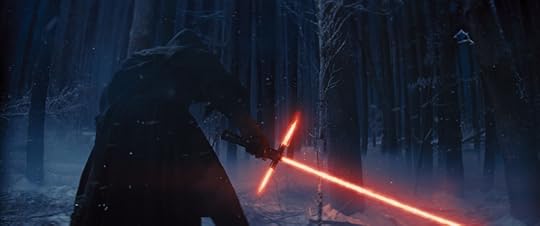
That crossguard…
Okay, still here? Let’s do this. For the purposes of this post, I’m assuming that lightsabers themselves are actually feasible and follow a consistent set of internal rules as seen in the movies. I’m not going to get into the science of ‘can this thing be built at all?’ I’m going to assume it can be. I’m also going to stick mostly to the movies instead of the expanded universe and spin-offs and whatnot.
Lightsabers are still one of the most problematic weapons ever invented by Hollywood. It has ISSUES, giant issues, above and beyond it being feasible to build one.
It has no weight
This is actually important. Handling a weapon that has no weight is HARD. Try picking up a tube-shaped object around the size of a lightsaber handle and waving it around – this is what a lightsaber feels like. Try doing the same with a cardboard tube, which is closer to what a sword with a physical blade feels like. What you’ll notice – or, at least, what I notice – is that handling a sword-like object is easier to control than handling a lightsaber-like object, because the weight and balance of the physical object conveys more information about where the “blade” is.
Sure, you can argue that the Force makes it possible to handle a lightsaber without it, but the point still stands – it’s an unnecessary handicap. Why is it unnecessary? Because if they can make a whole blade out of light or plasma or whatever, they could make a physical blade with just the edge made out of the same.
It sucks against ranged weapons
This should be super obvious, but I’m going to say it anyway. There is no, repeat NO reason to take a melee weapon into a pitched battle in an age where advanced ranged weapons are common. Blasters don’t run out of ammunition in any practical way; they’re recoil-less, one-shot-kill weapons that appear to be just as effective in close combat as long range combat. The whole ‘blocking shots with the lightsaber’ schtick only works from the front and because every mook in Star Wars can’t aim.
Lightsabers in general don’t work against a military commander who knows anything about actual tactics. They can’t block artillery shells, for example. They can’t block flamethrowers, and flamethrowers are even easier to make than guns. The original trilogy had the good sense to never, ever put someone with a lightsaber into a large massed battle like we see in the prequels, and they still had some pretty silly instances of lightsabers vs. ranged weapons.
The handle is round
You wouldn’t think that this is important, but it is – lightsaber handles are round. Sword handles should not ever be round, because it means it’s impossible to feel the edge alignment of the blade. (The edge alignment is essential because you need to strike with the edge at 90 degrees to the impact area in order to do damage, instead of bouncing off or hitting with the flat.) Now, you’d wonder why this is an issue, seeing as lightsabers technically don’t have edges at all, but here’s the thing – lightsaber fighting is based on swordfighting with actual blades where edge alignment matters. If you watch any lightsaber duel, it’s obvious that the fighters use lightsabers as if there is an edge to strike with.
So the problem here is two-fold – they fight as if it has an edge, even when it doesn’t, and the handle doesn’t make sense for a weapon with an edge.
Lightsaber ballet
Lightsaber ballet, people. Hollywood swordplay is pretty unrealistic anyway (not always a bad thing), but lightsabers turn it up to eleven and make it ridiculous. The fighters whirl around like spinning tops with glow-sticks attached most of the time.
I call it ballet because that’s what it is: people spinning around. Spinning 360 degrees in the middle of a fight is STUPID. You can definitely do a 180 – see Jogo de Pau, the Brazilian stick-fighting school that includes some really interesting stuff for combat against multiple opponents – but that’s in the context of striking a person in front of you and then immediately turning to defend/strike a person behind you. Lightsaber fights do complete turns against single opponents. (FYI: do this in an actual swordfight and you will get killed. And laughed at. Not necessarily in that order.)
The prequels are the worst offenders for this. The original trilogy stuck to the whole idea of lightsabers being used for symbolism, in duels between Force-users. It’s everything made afterwards that’s idiotic.
It’s not stealthy
One of the few advantages that a blade has over a gun is that a blade is an excellent stealth weapon. A gun is not. A suppressor can’t completely eliminate the sound of a gunshot, no matter what you see in the movies; the real purpose of a suppressor is to reduce hearing damage from repeated firearms use, or to alter the sound so that it doesn’t appear to be a gunshot. It also reduces recoil and hot gas emissions, which is obviously better for the shooter. But you cannot and will not ever be able to silently kill someone with a gun. A blade, however, is completely silent, and invisible as long as it has a coating to remove the shine.
In comparison, lightsabers are noisy as hell. Activating one and waving it around generates light and sound that cannot be suppressed, as far as we know. Lightsabers intentionally throw away this advantage.
It’s not versatile
A lightsaber can cut through most stuff. (There is a list of lightsaber resistant materials on the Star Wars wiki.) But being unimaginably razor-sharp is not an advantage if you want to use this thing in combat, because it means it’s dangerous to the wielder, as many people have said before, AND it means that you’re automatically unable to use many useful techniques. Half-swording (grabbing the blade with your hand for extra leverage and point control), is impossible. Outside of the razor-sharpness issue, lots of basic defensive techniques are impossible because lightsabers do not have effective crossguards. (Remember, lightsabers are used in ways that mimic swords with crossguards.) So binding an opponent’s non-lightsaber weapon is impossible. Most importantly, in my opinion, maintaining control of an opponent’s non-lightsaber weapon is impossible. In both cases, you’ll either cut straight through it or, if the material is resistant, get your own hands cut off.
Consider a Jedi with a lightsaber fighting a Sith with a conventionally-shaped sword made out of lightsaber-resistant material. If they’re equally skilled, the Sith will win simply because they have many more options for attacking and defending.
That crossguard, seriously
I said ‘effective’ above for a reason. It’s stupid, even for Star Wars, and that’s saying something. Crossguards have several uses on a sword; for protection, to prevent the user’s hand from sliding up onto the blade, to control and bind the opponent’s blade, and in techniques such as the famous Mordhau, or the ‘murder-stroke’. I’m assuming that the Force-user in this case is skilled enough not to hurt themselves with it, but it’s still not effective at any of these functions.
Protection-wise, the crossguard stops a sliding blade before it cuts your fingers off. But lightsabers do not slide, or at least we never see them slide in the movies. Lightsabers bind in a way that sticks them to other lightsabers, or they bounce off.
Preventing the user’s hand from sliding up onto the blade only really applies to blades that meet resistance. Lightsabers do meet resistance against other lightsabers, but this never, ever comes up and, as far as we know, is irrelevant to Force-users. If it were an issue, we’d have seen crossguards a long time before this.
Controlling and binding, again, only applies in the case where a blade slides down and can be caught on the guard. Lightsabers do not slide, ergo this is irrelevant.
The Mordhau requires the user to grab the blade and hit with the quillions, which is obviously a non-starter for a lightsaber. Striking with the quillions might work – emphasis on ‘might’, because that kind of strike doesn’t require quillions on both sides of the blade.
Conclusion
See, the problem with lightsabers is that they are not effective nor practical weapons, and in the original trilogy, it seemed clear that they were restricted to Force-users because they were part of the ‘religion’, as it were. They were part of the zen mystic of Jedi and Sith, rarely seen and largely only used in duels between Force-users. They were symbolic; as Obi-Wan Kenobi put it, ‘an elegant weapon for a more civilized age’, which is a pretty clear callback to the romanticized views of knighthood and chivalry from the Middle Ages. Notice that Luke goes from using a blaster in the first movie to using a lightsaber and the Force exclusively in the third, highlighting his development from farmboy to Jedi.
In the original trilogy, the swordplay was done by the legendary Bob Anderson, and it shows. Take a look at Obi-Wan Kenobi vs. Darth Vader in A New Hope. Watch how the fighters feel each other out, testing their crossing, disengaging, striking and parrying in precise, deft movements – exactly what you expect from a pair of sword-masters. Watch Luke vs. Vader in The Empire Strikes Back, and it’s far more chaotic – Vader is testing Luke, beating him down to the point where he offers him the power of the Dark Side. Finally, watch Luke vs. Vader in Return of the Jedi, and you’ll see Luke more controlled, more experienced, and ultimately the fight is an expression of his emotional state and his final rejection of the Dark Side.
This is why lightsabers are so powerful and compelling. Their usage in the original trilogy was almost entirely wrapped up in the mysticism of the Force and how it served the epic story of the downfall of the Empire, and they were used sparingly. Even beyond that, there was a subtle implication that a Force-user could grow beyond needing one at all. Yoda didn’t need one, and the Emperor thought they were toys. None of what I’ve said above really matters while lightsabers are meant to be something more than mere weapons.
Everything after the original trilogy is where it just falls apart, especially in the prequels, because the whole concept of the ‘elegant weapon’ goes right out the window. Lightsabers become downright silly because they’re shoved into every battle and situation, treated like they should be a practical choice when they are not, and used in ways that are frankly insulting to both sensible swordplay and proper storytelling. All the mysticism, the power of the symbol, is totally lost. I would also like to point out that the lightsaber choreography of the prequels was done by stuntmen, not fencers; people who have an understanding of showmanship and flashy effects above all else. Not swordplay. Not storytelling.
So there you have it. Take all of this as the opinion of a swordfighter and writer for what it’s worth. I’m afraid I have no faith that the new movie next year will be anything more than the same as what we saw in the prequels, especially seeing as it’s being directed by J.J. Abrams and we all know what he did to the Star Trek movies. Still, I’m prepared to be pleasantly surprised.
I’ll write a more complete post at some point about the use of lightsabers in the prequels, and trust me… it will not be pretty.
Related Posts:
The Best Movie Swordfights – The Princess Bride
On plate armour, movement, and fighting with longswords
Syrio Forel vs. The Lannister Guards
The Swordplay of Lord of the Rings
The post The Problem With Lightsabers appeared first on Raynfall.
January 3, 2015
“A great musician once told me…”
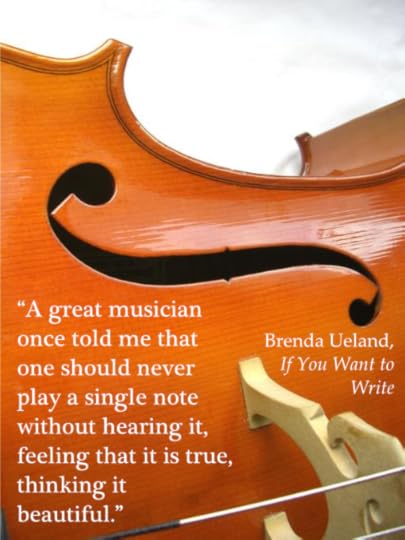
Brenda Ueland was an incredible writer and an inspiration to all.
Image courtesy of Wikimedia.
Related Posts:
No Related Posts
The post “A great musician once told me…” appeared first on Raynfall.
January 1, 2015
Syrio Forel vs. The Lannister Guards
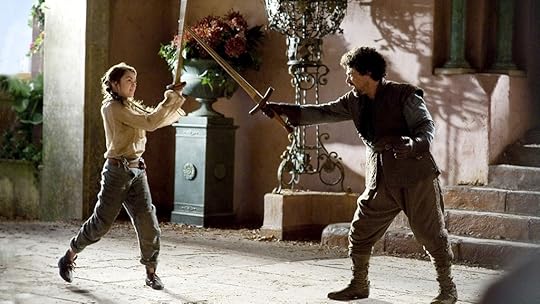
A friend sent me this clip from A Game of Thrones, and asked for my opinion on the swordfighting. Full disclosure: I don’t watch the series, I’ve never read the books, and my knowledge of the whole thing is virtually nil. That being said – let’s take a look.
So the first thing I notice about this is that there isn’t a whole lot of swordfighting going on. This is actually a good thing! What we see feels a lot like the usual baseball-bat-flailing ballet-dancing kind, and the less of that in the scene, the better.
Honestly – the real meat of this clip is in Syrio speaking to his student. “What do we say to the god of death? Not today.” The action is typical modern Hollywood; difficult to see, using camera tricks to make it appear faster than it really is, and mostly about hitting the opponent’s sword instead of their body. But at least they’re mixing it up a little here – the stances that Syrio takes at the beginning of each fight sequence are vaguely similar to the rapier guards that I’m familiar with, and the use of wrestling techniques is interesting.
The problem is that it’s just not enough. This is supposed to be a master swordsman, if my quick read of the wiki is correct, who specializes in a style of combat that emphasizes a light sword and expert balance – very much a duelist, which makes sense. But he doesn’t fight like one! It’s more of the same – big, swinging, inefficient, baseball-bat arcs. And it’s actually slow, if you ignore the jump-cuts and other camera movements; really slow and ponderous. Rapiers – if we’re assuming that he’s patterned after a rapier duelist – are blisteringly fast and very precise. A good fencer could stab two guards through the body part of their choice in the time it takes Syrio to swing and hit once.
So bottom line here, this is action for action’s sake; apart from the fact that Syrio defeats the guards, it doesn’t add any strength to the story-telling.
Now, this is also pushing the limits of what I’d consider to be believable. Normally I wouldn’t bother pointing this out, but good grief, this is close to ludicrous. Syrio is one unarmored man with a wooden sword, against four men in steel plate with steel swords. Never mind the fact that his training sword would break from a single solid parry – there is no possible way that a wooden sword is going to do any significant damage to an opponent in steel armor. Absolutely none! It’s a wooden stick, for gods’ sake – plate armor was made to withstand multiple blows from steel longswords! People didn’t wear it because it was fashionable, they wore it because it worked. A single strike to a steel helmet using a bloody wooden stick, no matter how skilled the wielder, is going to knock the victim off balance for maybe a few seconds at most, provided the helmet wasn’t made by an idiot who’s only had helmets described to them by other idiots.
It didn’t have to be like this. Consider, for a second, the brief scene where Syrio ducks and one of the guards bashes the other across the face by accident. That feels like more of what a duelist would do, against a couple of armored men: use the advantage of speed and agility to dodge like he’s got built-in bullet-time, get them to hit each other, then use the moment to lever them to the ground and do horrible things to them (like what was done with actual half-sword techniques, imagine that!). Better yet – use the moment to disarm one of them, get a proper steel sword, and use it like a rapier to find the gaps in their armor and skewer them. That, I believe, would be a far better representation of the so-called ‘water dancing’ style, as described in the wiki.
I know A Game of Thrones is hugely popular, even though it’s not my particular cup of tea. But really? For a series this expensive, they could do so much better.
Related Posts:
The Best Movie Swordfights – The Princess Bride
The Swordplay of Lord of the Rings
The post Syrio Forel vs. The Lannister Guards appeared first on Raynfall.
December 31, 2014
“Writing is the closest thing we have to telepathy…”

You know it’s true.
Related Posts:
So You Just Want to Write
Why You Should Be a Writer
The post “Writing is the closest thing we have to telepathy…” appeared first on Raynfall.
December 30, 2014
The Best Movie Swordfights – The Princess Bride
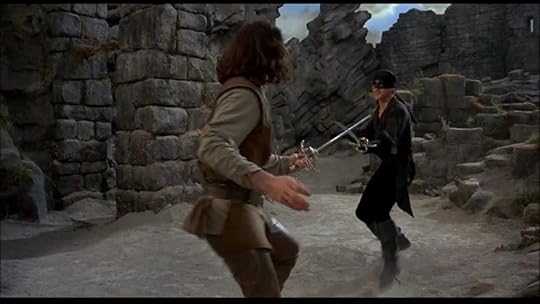
So I’ve talked a little about what makes movie swordplay boring… Now it’s time to talk about the good stuff. The best stuff. And where better to start?
Yes, it’s Inigo Montoya vs. the Man in Black. Believe me when I say that this whole fight is pure, unadulterated gold.
It’s Classic Movie Swordplay
Straight out of the old Errol Flynn black ‘n’ whites, in fact. The actors talk as they fight, moving around the arena, and there’s the usual reversals and counter-reversals and whatnot. It’s just so much fun to watch!
It’s Character-Defining
Oh man, is it ever. From the start to the end, every beat tells us a little more about the characters. Characterization is so important in every story. In the movie, this is the first time we really see the Man in Black, and the fight establishes all these little facts about him that you probably didn’t even realize you were aware of. He’s merciful, up to a point; knowledgeable; highly skilled and focused; more than capable of deception; and possesses a somewhat dry sense of humor. Beyond all that, this fight establishes that he is a Good Guy, as opposed to Prince Humperdinck, who comes off as a bit of a tit.
The Music is EPIC
I would ask that any filmmaker who wants to see music being used really, really well to watch this fight on repeat for, like, an hour. Listen to how the music is patterned to the fight, and sometimes to the very sword swings. The music tells the audience how they should feel, when it swells and falls, when there is danger and when there is tension. The duel is almost a dance – obviously, because it’s been choreographed – and the dance must have the right music! If you’d like to test this, just watch the video with the sound muted. You’ll notice almost immediately that it loses a huge amount of impact.
Is it realistic? Hell no. It’s movie swordplay. They mostly aim to hit each other’s swords instead of making proper strikes. They spend a lot of time making large, slashing cuts with swords that are ostensibly designed for thrusts. They’re fighting at a measure that’s far too close. And you know what? None of this matters. Mandy Patinkin and Cary Elwes are actually fencing here, for the whole fight, except for the somersaults. They learned to fence, with either hand, just to do this movie – and they were trained by Bob Anderson. THAT Bob Anderson. The guy who basically did every swordfight in a movie that you remember. The guy who taught Errol Flynn to fight.
Honestly, I could just talk about this fight for hours. I could talk about this movie for hours. The Princess Bride is one of the greatest examples of storytelling mastery ever produced by Hollywood. It’s a perfect storm of creativity – every actor knocks it out of the park, for a start. The screenplay was written by William Goldman, the novelist who wrote the original book. It was scored by Mark Knopfler, from Dire Straits. It was directed by Rob Reiner. So many amazing, talented people came together to make it! Some movies become cult hits because of circumstance, but The Princess Bride got there simply because it really, really is just that good.
If you’ve never seen it, I beg you to go get a copy any way you can.
Related Posts:
The Swordplay of Lord of the Rings
The post The Best Movie Swordfights – The Princess Bride appeared first on Raynfall.

